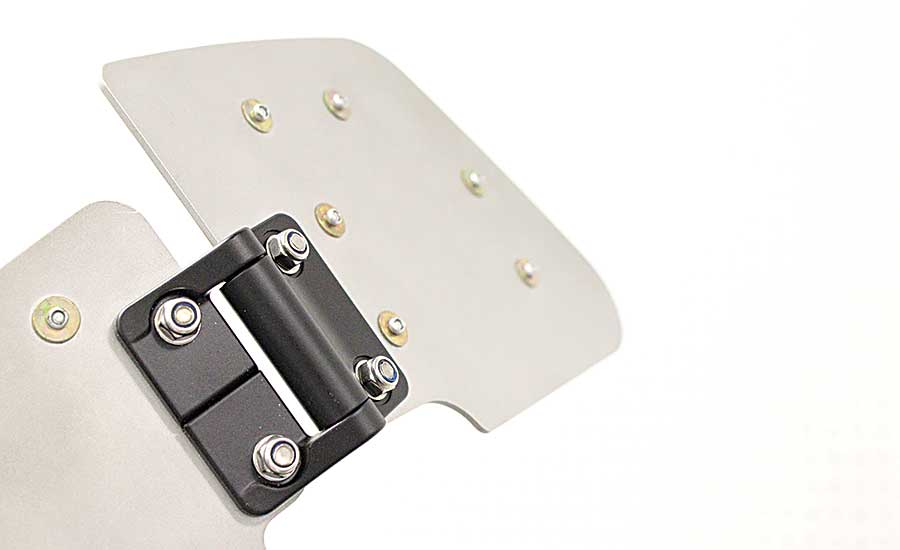New Hinge Designs Enhance Product Performance
Today’s hinges offer sophisticated functionality that design engineers can use to improve the operation of their assemblies.

Constant torque hinges with factory-set levels of resistance provide continuous resistance against motion. Such hinges can make a lightweight plastic table feel heavier and more substantial to the consumer. Photo courtesy Southco Inc.

Fixed-position detent hinges, like Southco’s C6 Series, provide tactile feedback and hold doors open at a predetermined angle. Photo courtesy Southco Inc.

Constant torque positioning hinges, like Southco’s E6 Series, provide reliable positioning with consistent operating effort. They also eliminate the need for secondary support components to hold doors or panels in position. Photo courtesy Southco Inc.

Southco’s CA counterbalance hinge has a spring system that takes the effort out of lifting and supporting lids, doors and panels by counteracting their weight. Photo courtesy Southco Inc.

Counterbalance torsion spring hinges, like Southco’s Lift-ASYST series, can be used to neutralize the weight of heavy doors. Photo courtesy Southco Inc.





The door hinge is among the world’s most widely used devices. This common piece of hardware may seem simple, at first glance, but in fact, hinges offer a sophisticated range of functionality that design engineers can use to improve the operation of their assemblies.
From fixed-position detent hinges that hold doors open at predetermined angles, to counterbalanced positioning hinges that control the effort needed to position panels or screens, designers across a range of industries can now leverage an array of innovative capabilities that have been engineered into today’s hinges.
Whether they are opening and lowering a tray table on an airliner, or adjusting the position of a card reader at a checkout counter, individuals draw impressions about a product from experiencing these “touch points.” The diversity and sophistication of the latest hinge technology provides design engineers with new tools to achieve unique touch point experiences in their products.
New Positioning Technology
The most common hinge is also the simplest: the standard, free-swinging hinge for opening and closing with no resistance. The hinge falls open under gravity and bears the weight of the device being moved.
Beyond this basic device, hinges have evolved into a new and highly useful product offering: positioning technology. With positioning hinges, designers can define and adjust the operating effort required to move or position doors, display screens, safety shields, lights—virtually any mounted component that is opened, closed and moved.
Positioning hinges represent a set of tools designers can use to fulfill ergonomic requirements and user perceptions of quality in their applications. These include:
- Holding doors open or closed, and moving panels securely into position without secondary supports or additional components.
- Creating an intuitive, zero-drift motion so that, when a door or cover is opened, it holds a user-defined or predefined position securely, and with one motion.
- Providing specific tactile feedback to enhance the quality perception of the hinged device.
- Eliminating additional components (such as gas struts) or routine maintenance (tightening screws to maintain hinge resistance), thereby helping to lower overall costs.
- Providing a smoother, more substantial feel to opening and closing action, or eliminating vibration.
Positioning hinges can elevate the consumer’s perception of the product in many ways. Consider the airplane tray table. Seating designers must use lightweight plastic components in these applications to help reduce the overall weight of the aircraft and thus conserve fuel.
However, a tray table that just flops down upon opening can lead a passenger to question the quality of the aircraft itself. Using a constant torque hinge with a factory-set level of resistance, the tray can be lowered with just the right level of force, making the tray feel more substantial and improving the passengers’ sense of the quality of their environment. In addition, constant torque hinges made from high-quality materials retain the desired resistance after thousands of flights, without requiring maintenance or parts replacements.
Positioning hinge technology can be broken down into four major categories, or “building blocks,” based on the type of controlled motion and positioning they supply:
- Constant torque hinges enable the device to be held securely at every position along the range of motion.
- Detent and bistable hinges automatically drive to a specific position (such as 90 degrees) and hold there.
- Counterbalance hinges have features that enable heavier objects to feel lighter when opened, or to pop open with a simple touch.
- Damping hinges control the speed of motion automatically. The user does not have to hold the door to control its speed
Although many applications would require only one type of hinge, these different categories can also be combined to create multiple positioning functionality in a single device.
Constant Torque Hinges
Constant torque hinges provide both smooth operation and infinite positioning. This allows for intuitive movement of a device, such as a laptop or a display screen at a checkout counter. When movement is stopped, it holds the hinged component at any point throughout its full range of motion.
The amount of effort to move the hinge is just enough to respond to deliberate motion, while holding the component in place for more casual or touch interactions.
A common example of this is the touch screen monitor at a checkout counter. A constant torque hinge attaches the monitor to the base, allowing the cashier to easily tilt the screen up and down for optimum viewing. At the same time, the cashier can tap icons and touch points on the screen without shifting the monitor from the desired position.
Traditionally, this capability was accomplished with clamping or latching mechanisms. However, these devices often do not provide the infinite positioning ability of a constant torque hinge, nor do they provide the smooth, flowing tactile feedback. In addition, a constant torque hinge provides one-handed operation, rather than pushing a button or flipping a lever to move the device.
Constant torque hinges can also be engineered to provide asymmetric torque: Different amounts of effort are required to move the hinge in one direction: open or close, up or down. This feature has been used in certain types of headrests in airplane seats. The passenger can pull the headrest wings forward in the low-torque direction easily, while the high-torque direction resists the weight of the head leaning on the rest.
Detent Hinges
Detent hinges provide specific motion and tactile feedback: The door or device is opened and locks into place at a preset angle, usually with a distinctive “click” that can be felt. These types of hinges are often useful for lightweight cabinet doors or other devices that must be consistently opened and positioned out of the user’s way. Detent hinges require the user to keep moving the device until it reaches the right position for the working environment, for instance, a preset angle of 90 degrees.
A variation on detent hinges are bi-stable hinges. This hinge contains a built-in spring mechanism that automatically drives the door or device to the preset angle once the door is open. This functionality is useful for doors, access panels or covers that must be opened to a minimum angle for easy entry, or to avoid collisions with the surrounding equipment. The bi-stable mechanism automatically rotates the panel to one of two preferred positions, either fully open or fully closed, with simple touch operation.
There are alternatives to bi-stable detent hinges. For example, designers could use a basic hinge in conjunction with gas struts or gas springs to achieve the desired functionality. However, that adds cost to the product. With the bi-stable detent hinge, the hinge does all the driving.
Counterbalance Hinges
Counterbalance hinges facilitate the opening and moving of heavy doors and other fixtures. They incorporate heavy-duty counterbalance springs that store energy when the door or fixture is closed; upon opening, the energy is released and the effort to move the door to a fully open position is minimal. The hinge does most of the work.
Counterbalance hinges are good for applications where the element being lifted has significant weight, making operation safer and easier for the user. Medical equipment, such as blood analyzers or centrifuges, is one example. Large-capacity deep freezers are another.
For applications where operators routinely open and close heavy doors—industrial copiers, for example—counterbalance technology can help reduce fatigue and improve operator efficiency. For instance, a door with a symmetric torque hinge may require 2.3 kilograms of effort to open from fully closed to 90 degrees open. Using a counterbalance hinge, the energy required to open the door can be reduced to 0.9 kilogram.
In the past, designers would incorporate gas struts or other devices to provide the added lift. Counterbalanced hinges provide a more economical alternative. And, the newest counterbalanced hinges can incorporate a latch to support pop-up opening: When first opened, the heavy door lifts a few degrees. The user then pushes gently to fully open it to the desired position.
Damping hinges: Controlled Opening
Damping hinges provide designers with a unique option: Rather than control the position of the device, they control the speed with which it moves. With a damping hinge, a door or other component moves steadily to the open or closed position when force is applied.
This kind of smooth, steady motion is becoming preferred in a number of high-end applications, such as car interiors. For items such as eyewear storage compartments, USB port carriers, and other compartments that are opened and closed, damping hinges give consumers the impression of a high-tech, finely engineered interior.
Adding Tactile Value
Design engineers need not content themselves with just one of the four basic types of positioning hinge. Rather, they can be combined to satisfy multiple requirements. For example, detent and damping functionality can be combined in a single hinge, so that a door opens easily to a fixed position and clicks in place, and then moves on its own in a controlled fashion to the closed position when it is pushed shut.
The key is to determine the full usage case for each application. What ergonomic effort should be expended to open, position and close a device? What user feedback is needed to accomplish this motion effectively and repeatably? Hinge suppliers have extensive experience working through these usage cases to help define the optimum solution. They can provide in-depth expertise to cost-effectively configure the right positioning hinge for each application.
For more information, call 610-459-4000 or visit www.southco.com.
Looking for a reprint of this article?
From high-res PDFs to custom plaques, order your copy today!









